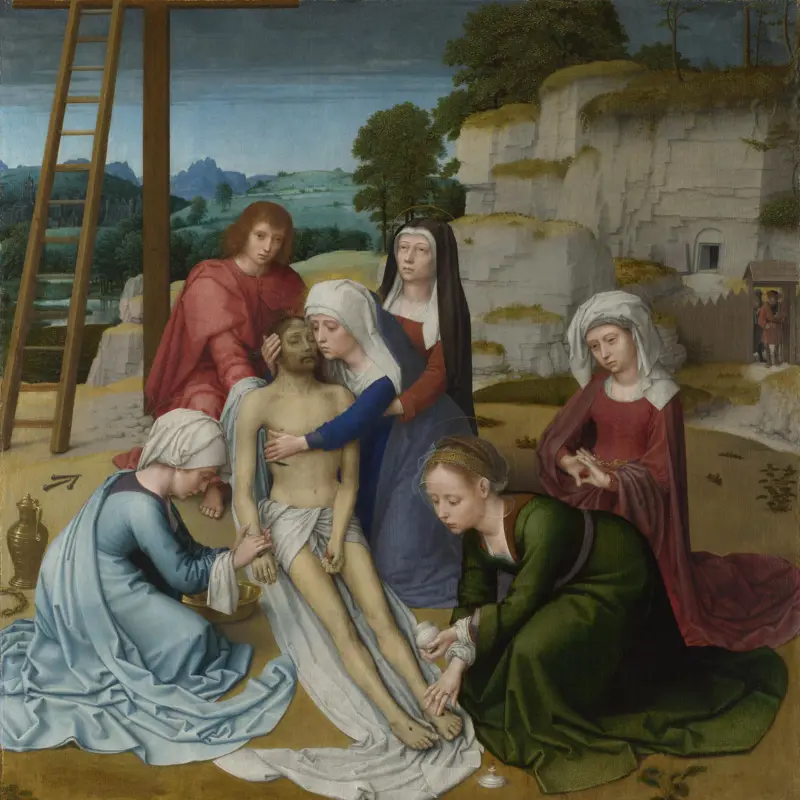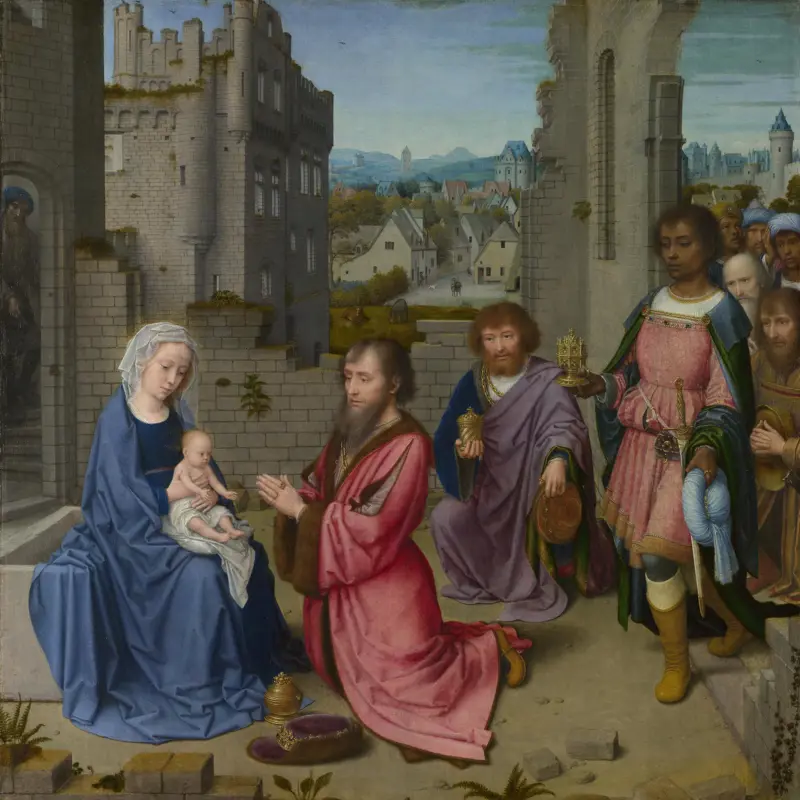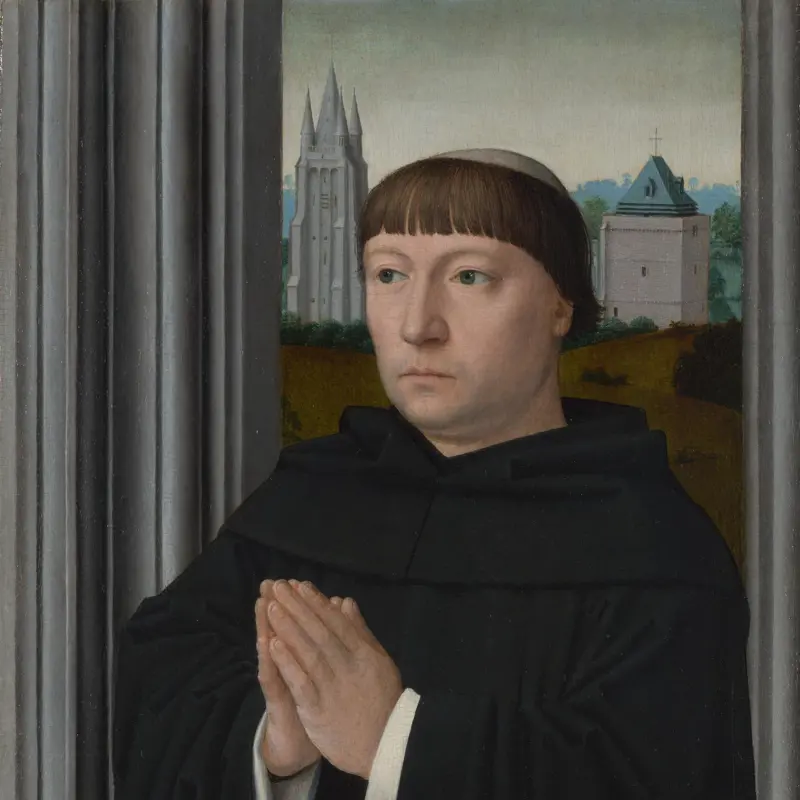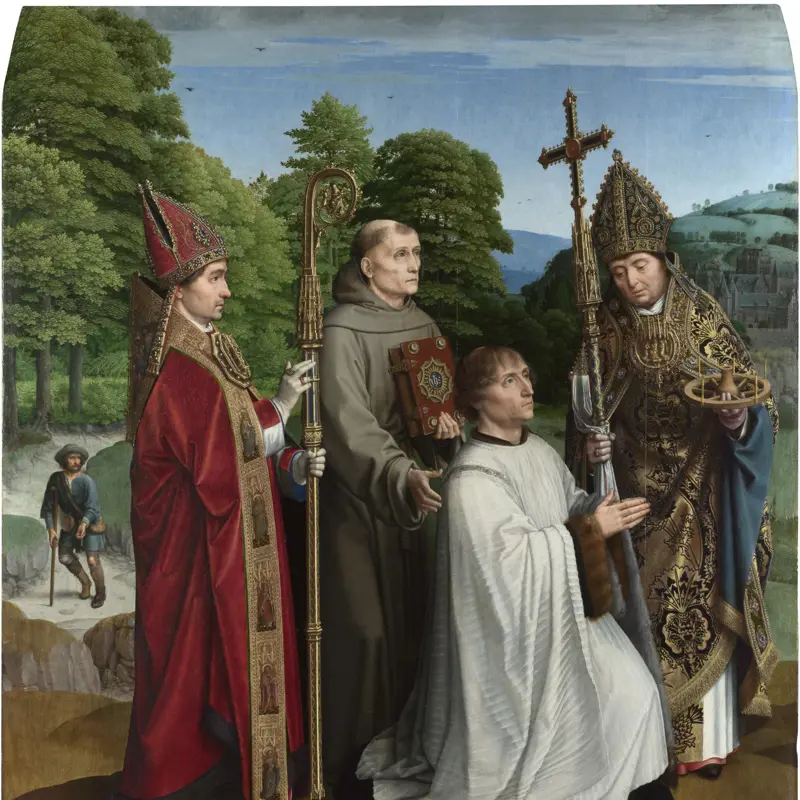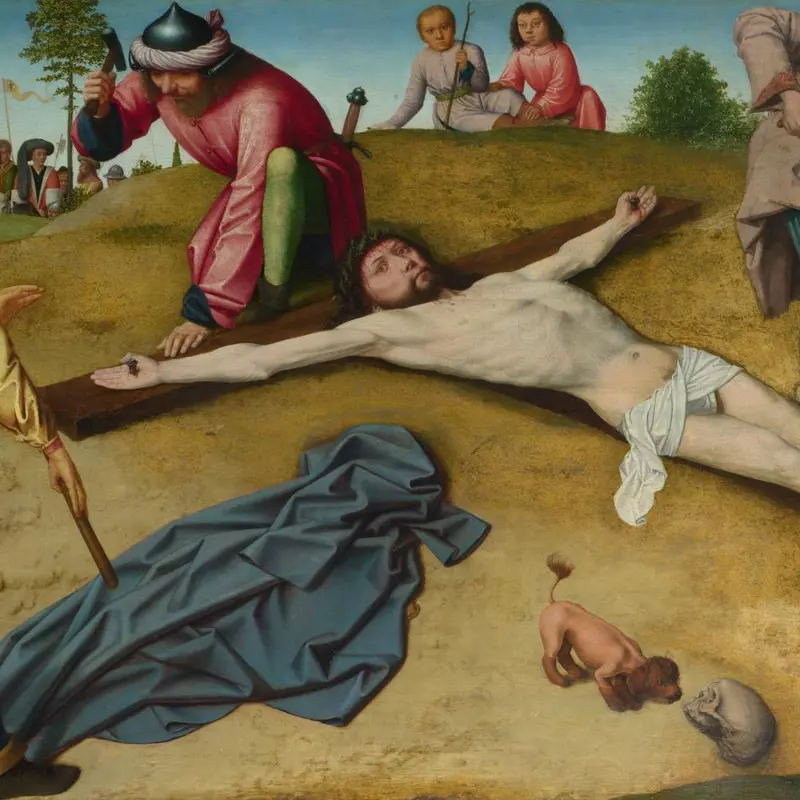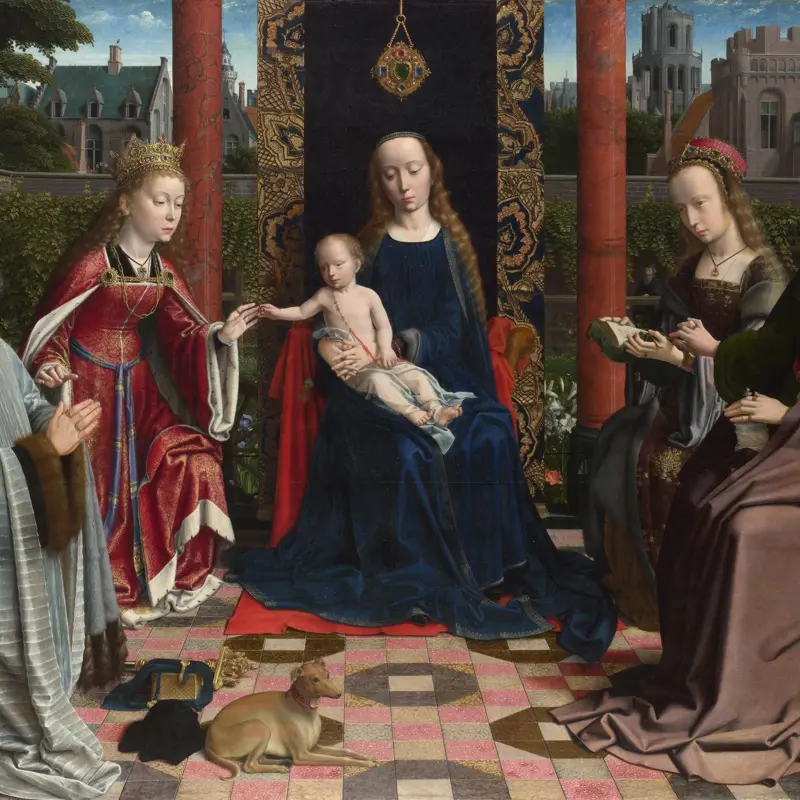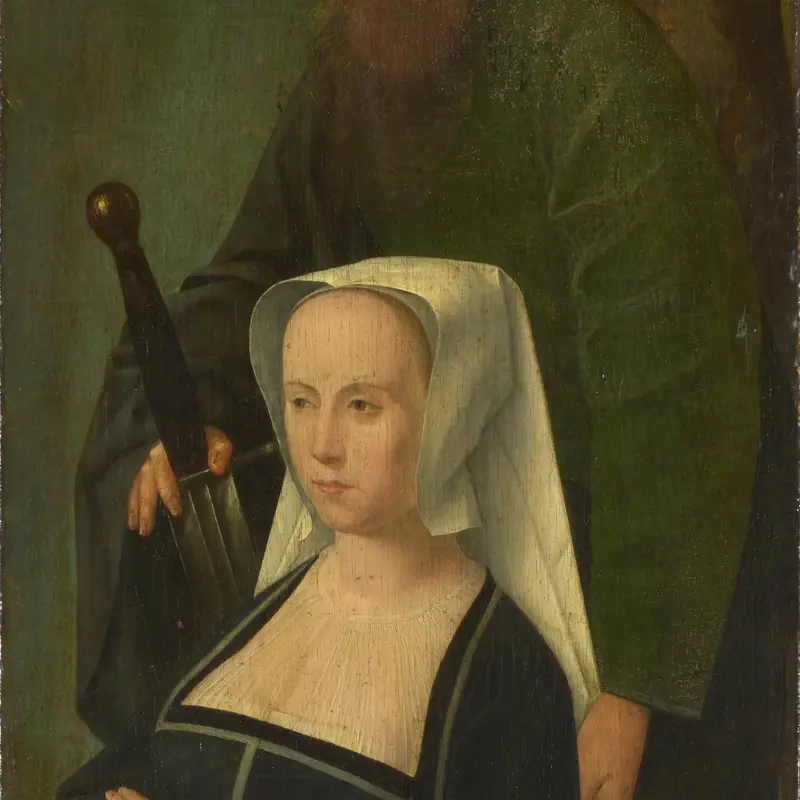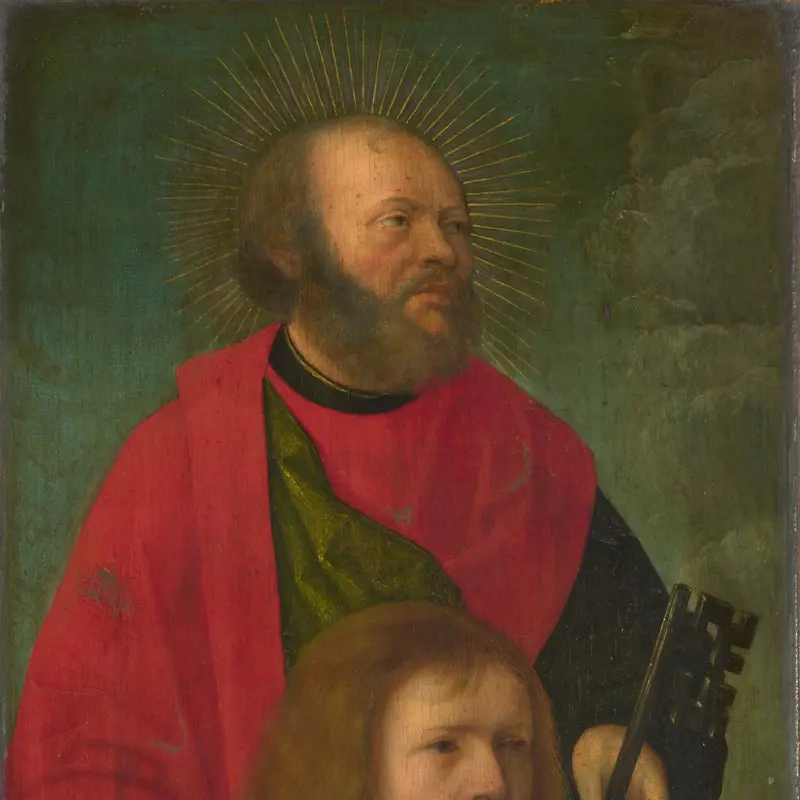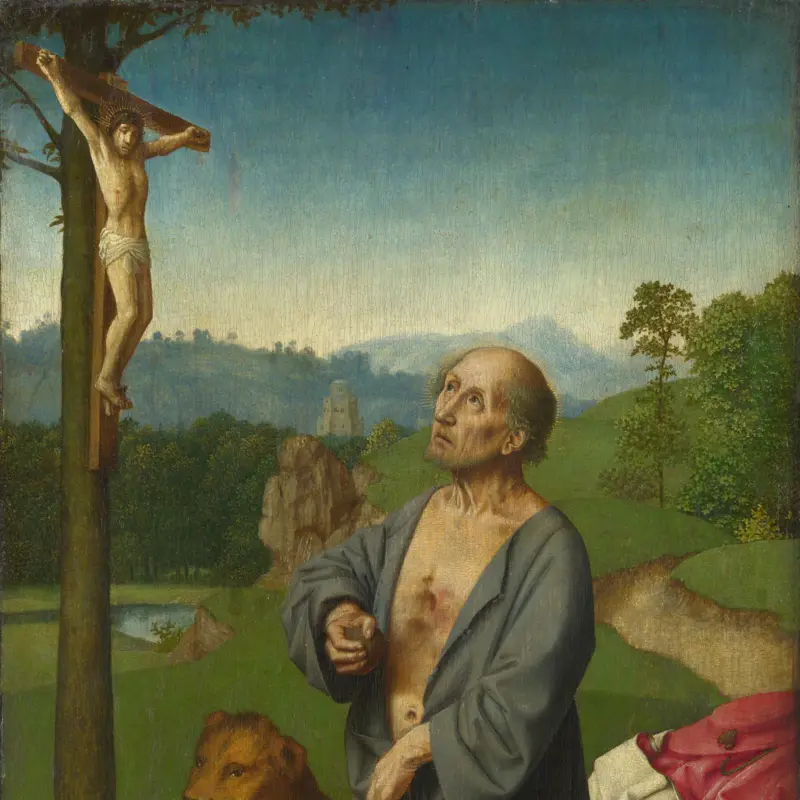Gerard David, 'Adoration of the Kings', about 1515
About the work
Overview
The Three Kings – Caspar, Melchior and Balthasar – present gifts to the Christ Child in the ruins of a grand building. The Virgin Mary sits on the edge of the manger while Saint Joseph, her husband, comes down a staircase just visible to the left. A crowd of curious onlookers, some wearing turbans, peer through the arch on the right. In the field behind Caspar’s head we can see an ox and a donkey, while everyday life goes on in the street of the town behind.
This painting was perhaps once part of a polyptych (a multi-panelled altarpiece) showing the life of Christ painted by Gerard David in Antwerp after 1515. It is likely that a similarly sized panel, the Lamentation, comes from the same complex.
Key facts
Details
- Full title
- Adoration of the Kings
- Artist
- Gerard David
- Artist dates
- Active 1484, died 1523
- Part of the series
- Two Panels from an Altarpiece
- Date made
- About 1515
- Medium and support
- Oil on wood
- Dimensions
- 60 × 59.2 cm
- Inscription summary
- Inscribed
- Acquisition credit
- Bequeathed by Mrs Joseph H. Green, 1880
- Inventory number
- NG1079
- Location
- Room 53
- Collection
- Main Collection
- Previous owners
- Frame
- 20th-century Replica Frame
Provenance
Additional information
Text extracted from the ‘Provenance’ section of the catalogue entry in Lorne Campbell, ‘National Gallery Catalogues: The Fifteenth Century Netherlandish Schools’, London 1998; for further information, see the full catalogue entry.
Exhibition history
-
2010Jan Gossaert's RenaissanceThe National Gallery (London)23 February 2011 - 30 May 2011
Bibliography
-
1833J.D. Passavant, Kunstreise durch England und Belgien, Frankfurt am Main 1833
-
1835E. Foster & Son, A Catalogue of the Very Rare Collection of Italian, Ancient German, Dutch and Flemish Pictures: The Property of Charles Aders, Esq., London, 1 August 1835
-
1841J.D. Passavant, 'Beiträge zur Kenntniß der alten Malerschulen in Deutschland vom 13ten bis in das 16te Jahrhundert', Kunstblatt, XXII, 1841
-
1854G.F. Waagen, Treasures of Art in Great Britain: Being and Account of the Chief Collections of Paintings, Drawings, Sculptures, Illuminated Mss. […], vol. 2, trans. E. Eastlake, London 1854
-
1857J.A. Crowe and G.B. Cavalcaselle, The Early Flemish Painters: Notices of Their Lives and Works, London 1857
-
1863W.H.J. Weale, 'Gerard David', Le Beffroi, I, 1863, pp. 223-34
-
1865A. Michiels, Histoire de la peinture flamande depuis ses débuts jusqu'en 1864, Paris 1865
-
1866W.H.J. Weale, 'Gerard David II: Sa vie et ses œuvres authentiques', Gazette des beaux-arts, XXI, 1866, pp. 489-501
-
1881National Gallery, Descriptive and Historical Catalogue of the Pictures in the National Gallery: Foreign Schools, London 1881
-
1887W. Armstrong, 'Notes on the National Gallery', The Guardian, 1887
-
1902G.H. de Loo, Exposition de tableaux flamands des XIVe, XVe et XVIe siècles: Catalogue critique, précédé d'une introduction sur 'identité de certains maîtres anonymes, Ghent 1902
-
1905S. Reinach, Répertoire de peintres du Moyen Âge et de la Renaissance (1250-1580), 4 vols, Paris 1905
-
1920National Gallery, National Gallery: Catalogue of the Pictures at Trafalgar Square, London 1920
-
1921W.M. Conway, The van Eycks and Their Followers, London 1921
-
1924M.J. Friedländer, Die altniederländische Malerei, 14 vols, Berlin 1924
-
1929F. Dülberg, Niederländische Malerei der Spätgotik und Renaissance, Berlin 1929
-
1945Davies, Martin, National Gallery Catalogues: Early Netherlandish School, London 1945
-
1953M. Davies, The National Gallery, London, Les Primitifs flamands. I, Corpus de la peinture des anciens Pay-Bas méridionaux au quinzième siècle 3, 2 vols, Antwerp 1953
-
1955Davies, Martin, National Gallery Catalogues: Early Netherlandish School, 2nd edn (revised), London 1955
-
1967M.J. Friedländer, Early Netherlandish Painting, eds N. Veronée-Verhaegen and H. Pauwels, trans. H. Norden, 14 vols, Leiden 1967
-
1968C.D. Cuttler, Northern Painting from Pucelle to Bruegel: Fourteenth, Fifteenth and Sixteenth Centuries, New York 1968
-
1973The National Gallery, The National Gallery: January 1971 - December 1972, London 1973
-
1975J.M. Collier, Linear Perspective in Flemish Painting and the Art of Petrus Christus and Dieric Bouts, Phd Thesis, Michigan University 1975
-
1975D.G. Scillia, Gerard David and Manuscript Illumination in the Lowlands, Phd Thesis, Case Western Reserve University 1975
-
1980E.J. Mundy, 'A Preparatory Sketch for Gerard David's Justice of Cambyses Panels in Bruges', The Burlington Magazine, CXXII, 1980, pp. 35-6
-
1987Davies, Martin, National Gallery Catalogues: The Early Netherlandish School, 3rd edn, London 1987
-
1987D. de Vos, 'Gerard David', in Nationaal biografisch woordenboek, Brussels 1987, vol. 12
-
1998Campbell, Lorne, National Gallery Catalogues: The Fifteenth Century Netherlandish Paintings, London 1998
-
2001
C. Baker and T. Henry, The National Gallery: Complete Illustrated Catalogue, London 2001
About this record
If you know more about this work or have spotted an error, please contact us. Please note that exhibition histories are listed from 2009 onwards. Bibliographies may not be complete; more comprehensive information is available in the National Gallery Library.
Images
About the series: Two Panels from an Altarpiece

Overview
These two paintings – the Adoration of the Magi and the Lamentation – most likely come from a polyptych (an altarpiece made up of several panels) painted by Gerard David and his assistants in the workshop he set up in Antwerp in 1515. They are roughly the same size and the figures are painted on the same scale, and have been together since at least the nineteenth century. They may have come from a lost altarpiece showing scenes from the life of Christ.

